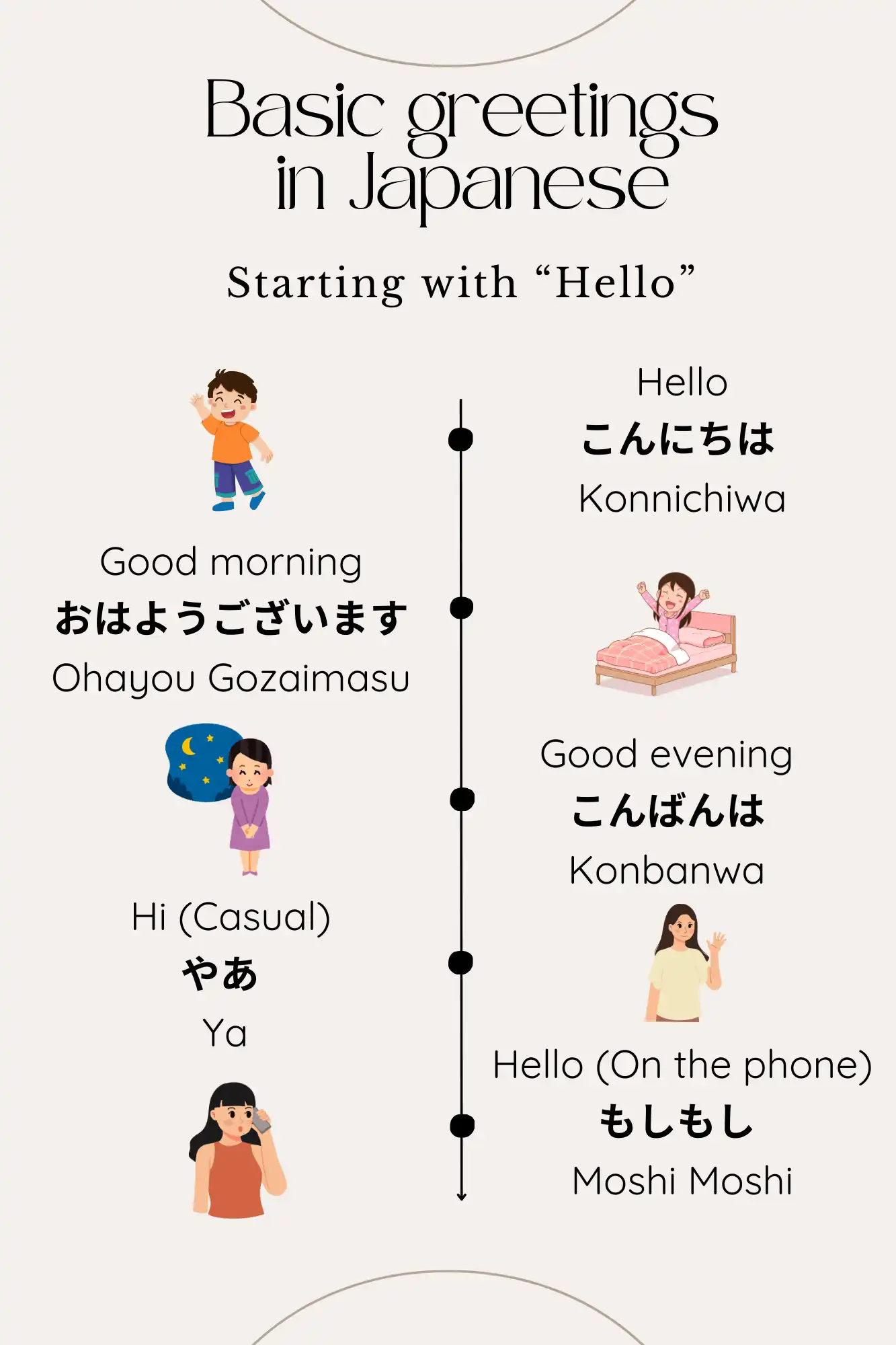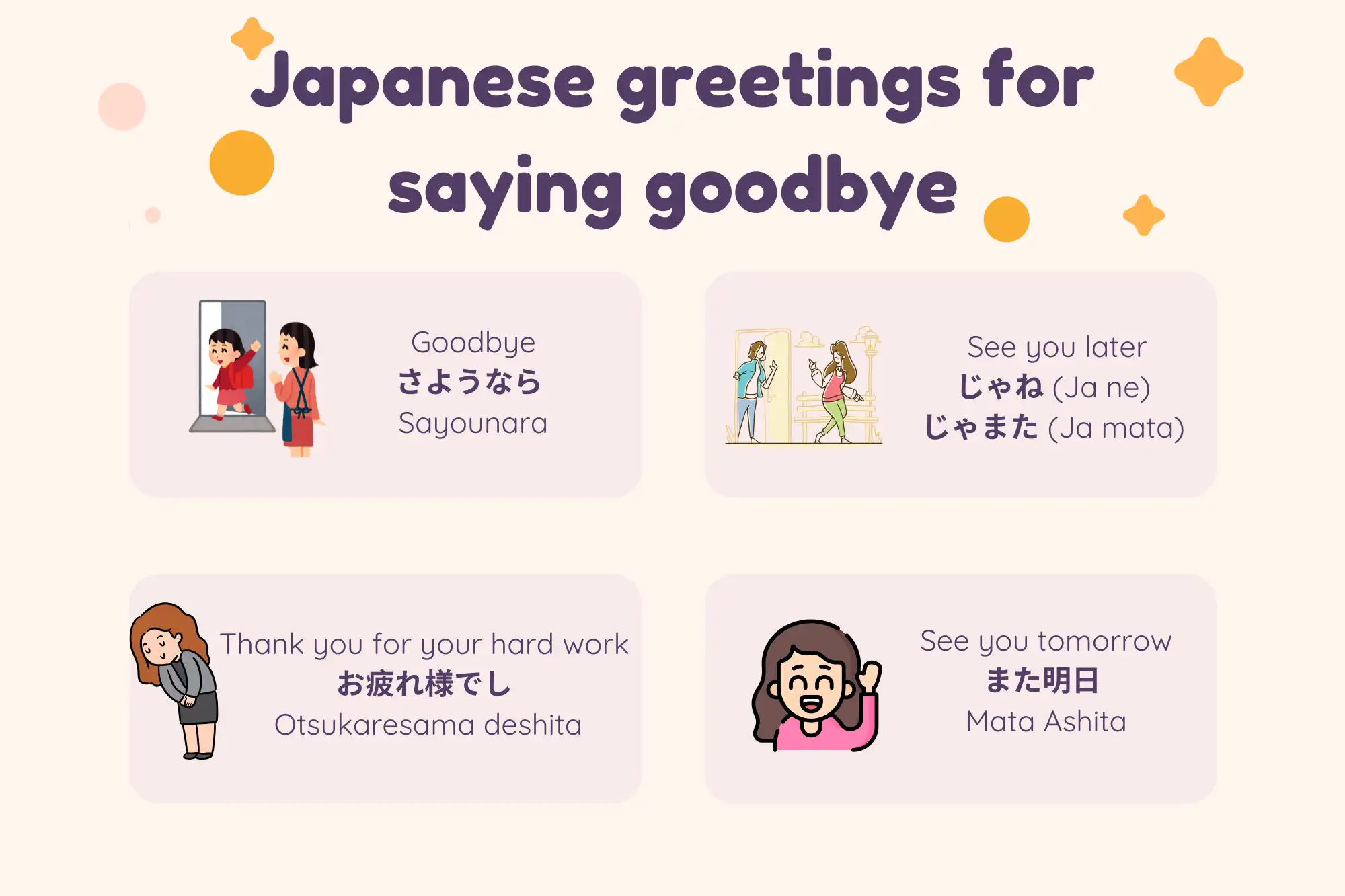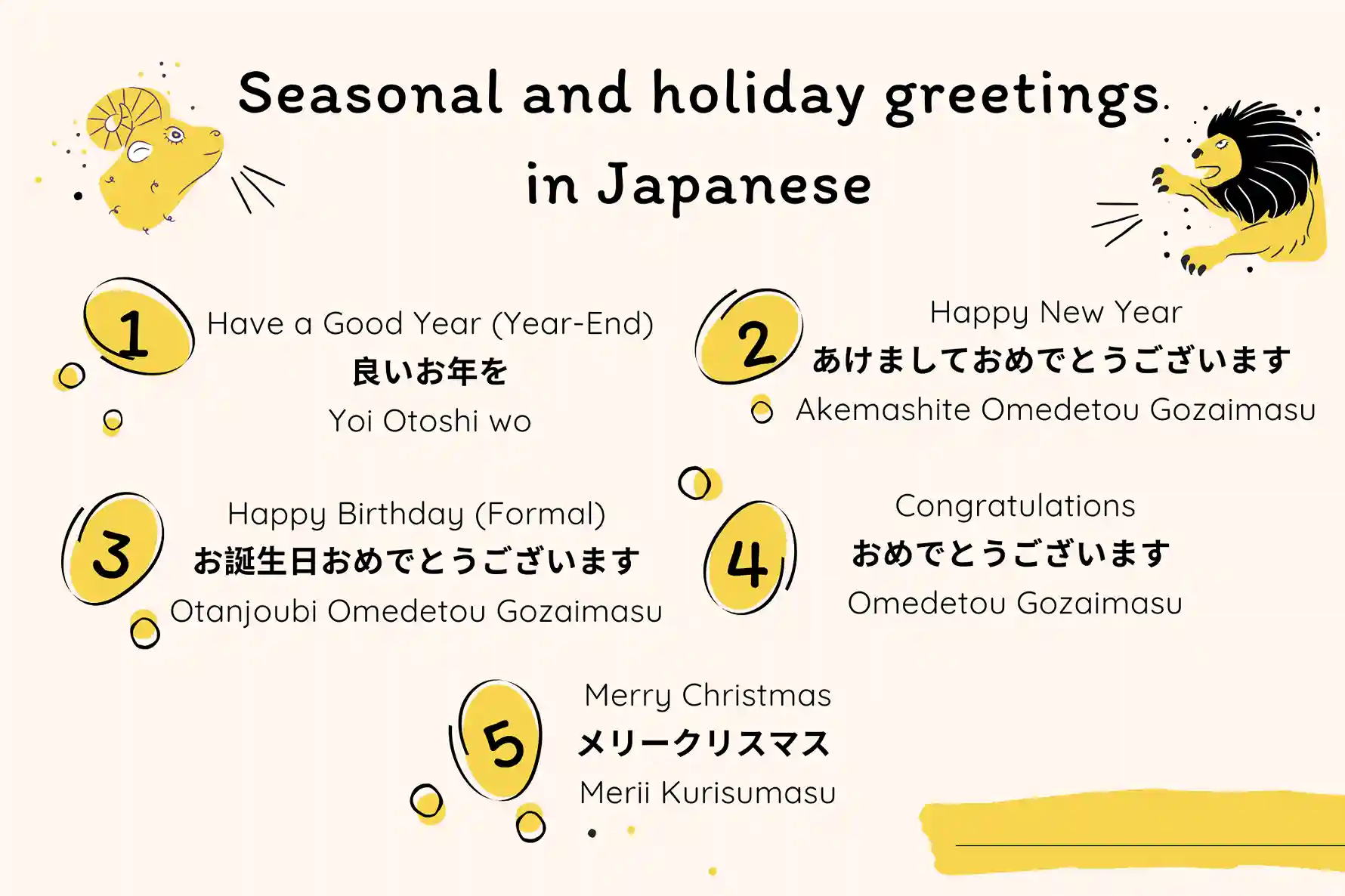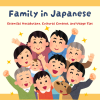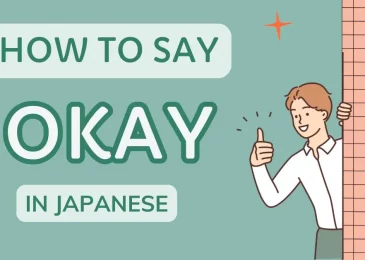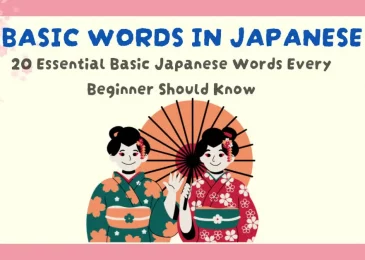Learning how to properly greet people is an essential step in mastering any language. Japanese greetings are not only words; they carry a deep sense of respect and cultural significance. This guide covers common Japanese greetings, helping you understand their meanings, how to pronounce them, and when to use them. From casual hellos to formal goodbyes, let’s explore the essential phrases for greeting in Japanese.
Why are greetings important in Japanese culture?
In Japanese culture, greetings are essential not only as polite expressions but as a way to show respect and acknowledge social roles. Japanese greetings also reflect the values of harmony, respect, and mindfulness, which are crucial in Japanese society. The way you greet others in Japan can influence first impressions, show attentiveness to the other person, and create a positive, respectful interaction.
Basic greetings in Japanese: Starting with “Hello”
Japanese has a variety of ways to greet others, with each phrase tailored for different times of day or specific situations. Here are some essential Japanese greetings and when to use each:
1. こんにちは (Konnichiwa) – Hello
Meaning: A standard greeting for “hello” that’s typically used in the afternoon.
“Konnichiwa” is versatile and can be used with friends, acquaintances, or even strangers. While it’s appropriate for most casual or formal interactions, keep in mind that “konnichiwa” is generally reserved for late morning through the afternoon. It’s a polite way to say hello without being overly formal, making it ideal for both social and professional settings.
2. おはようございます (Ohayou Gozaimasu) – Good morning
Meaning: A polite way to say “good morning.”
“Ohayou gozaimasu” is appropriate for formal or professional environments, particularly in the morning. If you’re speaking with colleagues, clients, or people you don’t know well, the formal version is most suitable. For close friends, family, or informal encounters, simply saying “おはよう (Ohayou)” is common and conveys a friendly tone.
3. こんばんは (Konbanwa) – Good evening
Meaning: A respectful way to greet someone in the evening.
“Konbanwa” is the greeting of choice for any evening interaction, whether casual or formal. This polite expression is often used when meeting friends for dinner, at social gatherings, or during evening events. It’s a courteous way to acknowledge the time of day and wish someone a pleasant evening.
4. やあ (Ya) – Hi (Casual)
Meaning: A casual and friendly way to say “hi.”
“Ya” is a relaxed greeting, ideal for informal settings with friends or people you know well. It’s mostly used by younger people and isn’t suitable for professional or formal situations. This expression is fun and simple, creating an easy-going tone among peers.
5. もしもし (Moshi Moshi) – Hello (On the phone)
Meaning: A unique greeting used exclusively for phone conversations.
When answering or making a phone call, Japanese speakers use “moshi moshi” as the standard greeting. Though informal, it’s widely accepted for almost any phone conversation, including casual chats and even certain work-related calls. “Moshi moshi” establishes that you’re ready to communicate over the phone, and it’s a culturally embedded part of Japanese phone etiquette.
Each of these greetings adds variety and nuance to your interactions in Japanese, allowing you to use the most appropriate expression based on the setting, time of day, and level of formality. Whether you’re meeting someone for the first time or greeting a close friend, these phrases help you navigate social situations smoothly and respectfully.
Japanese greetings for saying goodbye
Just like greetings for saying hello, Japanese farewells come in different forms, each suited to various levels of formality and context. Here are some commonly used phrases to say goodbye in Japanese:
1. さようなら (Sayounara) – Goodbye
Meaning: A formal way to say farewell.
“Sayounara” is used when you won’t see the person for an extended period, making it less common in everyday goodbyes among friends or family. This expression conveys a sense of finality, so it’s often used for situations where parting is more significant, like leaving a place for a long time or bidding farewell to someone you may not see again soon.
2. じゃね (Ja ne) / じゃまた (Ja mata) – See you later
Meaning: Informal farewells, similar to “see you” or “see you later.”
“Ja ne” and “Ja mata” are casual goodbyes that work well among friends, family, or close acquaintances. “Ja ne” is extremely informal and is popular among younger people, while “Ja mata” is slightly more polite and can be used when you want to add a bit of warmth to the farewell. Both phrases suggest you’ll see each other again soon and are suitable for friendly, casual settings.
3. お疲れ様でした (Otsukaresama deshita) – Thank you for your hard work
Meaning: An expression of appreciation for someone’s efforts, often used as a polite way to say goodbye.
“Otsukaresama deshita” is widely used in workplaces and formal settings to acknowledge everyone’s efforts at the end of the workday or after a shared task or meeting. It’s a respectful way to express gratitude for someone’s hard work and is commonly exchanged between colleagues when parting at the end of a shift or project. Saying “Otsukaresama deshita” not only shows respect but also brings a sense of camaraderie among team members.
4. また明日 (Mata Ashita) – See you tomorrow
Meaning: A farewell to use when you expect to see the person the next day.
“Mata ashita” is perfect for situations where you’re certain of meeting the person again the following day, such as at school, work, or regular gatherings. This phrase is friendly and relaxed, providing a nice, casual way to close the day with friends or colleagues.
Each of these expressions allows you to communicate the appropriate level of formality or familiarity, helping you navigate social situations smoothly. By using the right goodbye in Japanese, you can express warmth, respect, and a sense of connection in your farewells, whether you’re saying a quick “see you later” or a formal goodbye.
Formal greetings in Japanese
In professional or formal settings in Japan, certain greetings are expected to convey respect, politeness, and an awareness of social etiquette. These greetings are commonly used in business environments, official meetings, or other situations where formal communication is required. Here are some essential formal Japanese greetings:
1. はじめまして (Hajimemashite) – Nice to meet you
Meaning: This phrase expresses “Nice to meet you” and is used when meeting someone for the first time.
“Hajimemashite” is typically the very first phrase spoken in a formal introduction. It sets a polite and respectful tone, allowing both people to acknowledge the beginning of their interaction. Whether in a business meeting or a social gathering, starting with “Hajimemashite” conveys that you’re pleased to make the person’s acquaintance. It’s a standard phrase to open introductions and establish a courteous atmosphere.
2. よろしくお願いします (Yoroshiku Onegaishimasu) – Please take care of me / I look forward to working with you
Meaning: This versatile phrase is a polite expression used to request someone’s cooperation or assistance, often during introductions or when beginning a collaborative project.
“Yoroshiku onegaishimasu” is often said after “Hajimemashite” as a way to conclude the introduction. It conveys a sense of humility and respect, expressing that you appreciate the other person’s future help or collaboration. In professional settings, this phrase shows eagerness to work together harmoniously. Beyond introductions, it’s also frequently used when asking for assistance or guidance, making it a vital part of Japanese formal etiquette.
3. ご苦労様です (Gokurousama Desu) – Thank you for your hard work (Formal)
Meaning: This phrase is used to show gratitude for someone’s hard work, especially in formal work environments.
“Gokurousama desu” is commonly used by managers or superiors when addressing their team members, especially to recognize effort after a long day, a big project, or a challenging task. It’s a respectful way to acknowledge subordinates’ contributions and express gratitude. Unlike informal phrases of appreciation, “Gokurousama desu” carries a tone of authority, so it’s generally used only by those in higher positions.
Using these formal greetings helps foster a sense of respect and mutual understanding in Japanese professional culture. Each of these expressions plays a role in building rapport, showing appreciation, and maintaining the social harmony that is highly valued in Japanese workplaces and formal interactions.
Seasonal and holiday greetings in Japanese
Japan has a rich tradition of greetings that reflect the changing seasons and cultural holidays, allowing people to express warmth and well-wishes tailored to different times of the year. These greetings not only acknowledge the importance of specific occasions but also reflect a deep respect for the cultural rhythms of life in Japan. Here are some key seasonal and holiday greetings:
1. 良いお年を (Yoi Otoshi wo) – Have a Good Year (Year-End)
Meaning: This phrase is a way to wish someone a good year ahead, used specifically before the New Year actually begins.
“Yoi Otoshi wo” is commonly said in late December as a way to wrap up the year and bid farewell to friends, family, or colleagues until after the New Year. This year-end greeting is often exchanged in workplaces or with people you might not see again until January. It’s a friendly and culturally significant way to express goodwill for the upcoming year, capturing the Japanese custom of ending the old year on a positive note.
2. あけましておめでとうございます (Akemashite Omedetou Gozaimasu) – Happy New Year
Meaning: This is the traditional way to wish someone a happy new year in Japan.
When to Use It: This phrase is used at the start of the New Year, from January 1st onward, and is a standard greeting exchanged between friends, family, and acquaintances. “Akemashite omedetou gozaimasu” is often followed by “今年もよろしくお願いします” (Kotoshi mo yoroshiku onegaishimasu), meaning “I look forward to our continued relationship this year.” Together, these phrases embody the spirit of gratitude and connection that is central to New Year celebrations in Japan, where people exchange wishes for health, happiness, and success.
3. お誕生日おめでとうございます (Otanjoubi Omedetou Gozaimasu) – Happy Birthday (Formal)
Meaning: This formal expression of “Happy Birthday” is appropriate for wishing birthdays in respectful settings.
“Otanjoubi omedetou gozaimasu” is the formal way to say “Happy Birthday,” suitable for colleagues, superiors, or acquaintances. For close friends or family members, it’s common to use the slightly more casual “お誕生日おめでとう” (Otanjoubi omedetou). Birthdays in Japan are often quiet affairs, but expressing good wishes on someone’s special day is appreciated and helps to show thoughtfulness and respect.
4. おめでとうございます (Omedetou Gozaimasu) – Congratulations
Meaning: A general congratulatory phrase for various celebratory occasions, from anniversaries to personal milestones.
“Omedetou gozaimasu” is versatile and can be used for occasions like graduation, marriage, the birth of a child, or other significant achievements. It’s a respectful way to show happiness and support for others’ milestones and is often accompanied by a specific occasion, such as “ご結婚おめでとうございます” (Gokekkon omedetou gozaimasu) for “Congratulations on your wedding.”
5. メリークリスマス (Merii Kurisumasu) – Merry Christmas
Meaning: A Christmas greeting used in Japan, where Christmas is celebrated more as a festive, romantic occasion than a religious holiday.
“Merii Kurisumasu” is used around December 25th and is popular among friends, family, and couples. Christmas in Japan often involves light displays, gift exchanges, and festive dinners. Although it’s not a national holiday, this greeting adds to the cheerful spirit of the season.
These seasonal and holiday greetings play an important role in Japanese culture, offering ways to express care and goodwill that reflect the significance of each time of year. They also capture the Japanese value of maintaining harmonious and respectful relationships, making them a meaningful part of social interactions throughout the seasons.
Tips for learning how to greet in Japanese
Mastering Japanese greetings takes consistent practice and exposure to real-life scenarios. Here are some practical tips to help you learn and use greetings in Japanese confidently.
1. Practice every day
Set aside a few minutes daily to practice greetings. Small, consistent practice sessions build lasting memory and make it easier to retain phrases like “おはようございます” (Ohayou gozaimasu – Good morning) and “こんにちは” (Konnichiwa – Hello).
2. Use a spaced repetition app
The MochiKanji app is a great tool for mastering greetings in Japanese. Its spaced repetition system ensures you remember key phrases like “こんにちは” (Konnichiwa) by reviewing them at optimal intervals. It’s called the “Golden Time” feature, which helps you optimize your study schedule and focus on essential vocabulary.
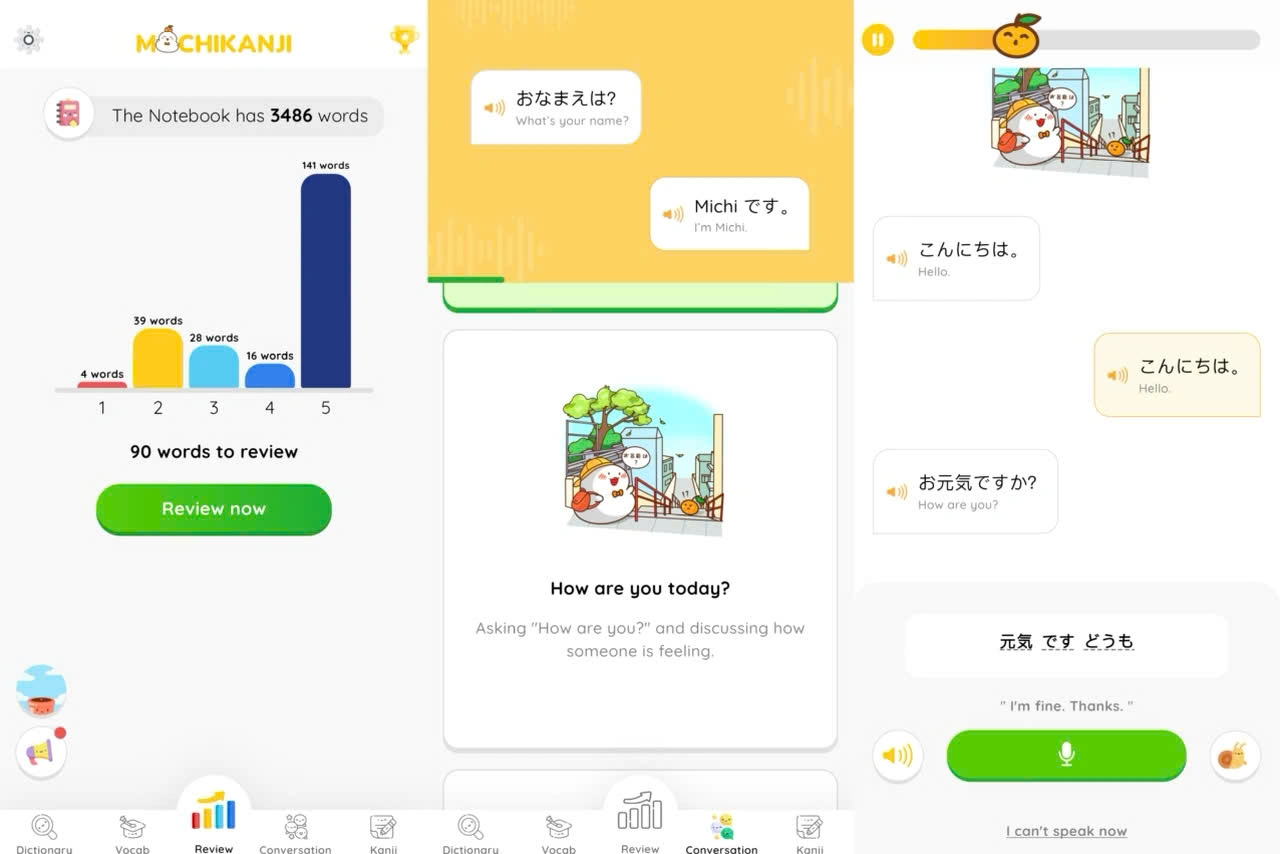
The app also offers conversation practice with interactive dialogues, helping you use greetings naturally. Additionally, its Kanji Writing feature teaches you how to write kanji correctly, including those used in greetings, improving both your writing and memory skills. With MochiKanji, you can effectively learn and use greetings in Japanese in everyday situations.
3. Immerse yourself in Japanese content
Watching Japanese TV shows, listening to Japanese music, or following a Japanese podcast exposes you to natural greetings in context. This is especially useful for learning the right tones and expressions. Try repeating phrases you hear and mimic their intonation to sound more natural.
4. Engage in real conversations
Practicing with native speakers or language partners helps you use greetings naturally and build confidence. If you don’t have access to native speakers, you can find online language exchange partners or participate in Japanese language groups.
5. Create visual reminders
Write out common greetings and place them around your workspace or home to keep them top-of-mind. Visual reminders help reinforce your memory and make it easier to recall phrases in real situations.
These tips will help you not only learn basic greetings but also use them appropriately in various settings. By combining consistent practice, immersion, and tools like MochiKanji, you’ll quickly feel at ease with Japanese greetings.
Frequently asked questions about greeting in Japanese
Q: What’s a polite greeting for someone you’re meeting for the first time?
A: When meeting someone new, start with はじめまして (Hajimemashite), then say よろしくお願いします (Yoroshiku onegaishimasu) to show respect and goodwill.
Q: Can I say “Konnichiwa” at any time?
A: While Konnichiwa technically means “hello” or “good afternoon,” it’s generally used from late morning to early evening. For morning, use おはようございます (Ohayou gozaimasu), and for evening, こんばんは (Konbanwa).
Q: Is “Sayounara” used often in Japanese?
A: Sayounara is somewhat formal and carries a finality, so it’s less common in casual settings. Instead, friends might use じゃね (Ja ne) or またね (Mata ne) to say goodbye.
Q: How can I greet someone politely over the phone?
A: Use もしもし (Moshi Moshi) when answering or calling someone on the phone. This greeting
Conclusion
Understanding and using Japanese greetings properly can elevate your communication and demonstrate respect for Japanese culture. Whether you’re traveling, meeting Japanese friends, or engaging in business, these greetings will help you leave a positive impression. With the right practice and cultural awareness, you’ll soon find yourself speaking with confidence and building deeper connections.

